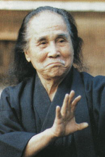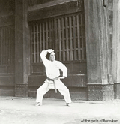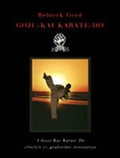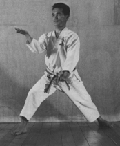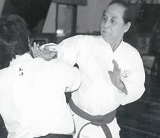100 Year Anniversary of Gogen Yamaguchi
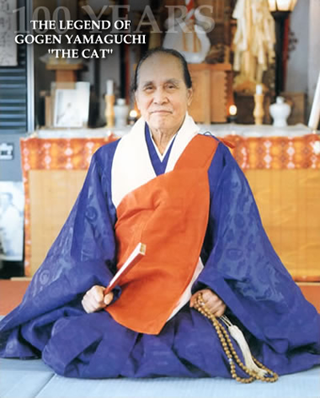
Gogen Yamaguchi was born on 20th January 1909 in Kagoshima Province, the southernmost region of Japan. This descendant of samurais certainly is one of the most complex figures striding the world karate stage, and a bundle of contradictions and his background was very interesting. As a young man growing up he was fond of athletics but it wasn't until the family moved to Kyoto while he was in his teens that he began the serious study of karate. Trained in the law, he was also a medical doctor. He studied all the major branches of the various arts and was a fifth degree black belt in judo. A Shinto priest, he is a deeply religious man. He also has the unmistakable flair that, if it were in any other field, he would have to be described as a showman.
On his deathbed in 1953, the old master Miyagi called for all the senior members of Goju Kai and announced to them his choice of a successor. It was then that Mr. Yamaguchi obliged himself the students of Goju in Japan to unite as an organization, Goju Kai. His leadership was unopposed and by virtue of his task the senior hierarchy of the Martial Arts Fraternity in Japan bestowed on him the honour of Grand Master, 10th Dan Hanshi. Being the head of this order he is called Kaicho.
"I shall be happy if you understand that the essence of the Martial Arts is not the strength, not the art, but that which is hidden deep within yourself."
Miyagi couldn't have made a better choice. Driving, relentless, Yamaguchi became the apostle of Goju in Japan. With single-minded determination, he set about the task of spreading the word throughout Japan. The first thing he did was to set about establishing dojo. He organized the first karate club at Ritsumeikan University and the first karate dojo in western Japan in 1930. Under his indefatigable leadership the school began to attract new adherents and the Goju karate system began to fan out across the island nation.
Early in the Japanese development, Yamaguchi made a fundamental change in the Goju School that was to alter radically the course of karate. After observing his students, he came to the conclusion that the strict Okinawan brand of karate, with its ancient Chinese origins, was too static and limited in style.
Free Sparring Developed
He believed that just the practice of kata (forms) and the prearranged steps in sparring called yajusoku kumite inhibited too many of the students. Under the movements of the Okinawan system, he noticed that many of the students could not create combinations of techniques readily enough or follow through with an advantage when an opening presented itself.
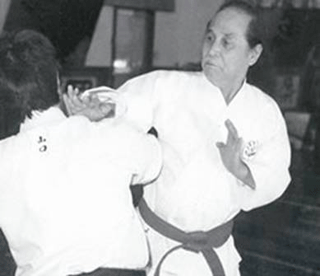
What Yamaguchi wanted to do was to open up movements to make for faster play and to allow greater freedom of movement. He wanted a system that could be tailored to individual needs yet still retain the basic fundamentals of the system. The idea he hit upon was kumite, or free-style sparring. At first, the kumite was systematized along boxing lines. After that, it was a natural step to go from free-style sparring to tournament play. But in going from the dojo to the tournament hall, the system of kumite underwent further transformation. Yamaguchi called upon his knowledge of the other martial arts to set up a tournament style. This time he leaned heavily on the principles of kendo (sword play) in devising rules of shiai (competitive) jyu kumite for sport. Kendo was favoured for two reasons: it emphasized form when delivering a strike and it limited the target area. Despite many differences with others over the areas to be left open for attack, Yamaguchi settled on the stomach and head as target areas.
As he explained in silencing his critics: "In kendo, a real blade can cut any part of the human body and cause damage or fatal injury. But for safety purposes, points are made for striking only the head and stomach." So too for karate, he said, the strike zone should be limited. And so were the types of blows that could be delivered. For shiai, the opponents are restricted mainly to kicking and punching. Elbowing, clawing, and other finger and open hand strikes were disallowed. However, for dojo free-style sparring, the play is wide open with no restrictions. For this reason, as has been often observed, the best player in the dojo may often not be the best tournament player, and vice versa.
With the freeing of karate from the strict adherence to kata and the addition of the competitive element, karate made tremendous strides in the next few years.
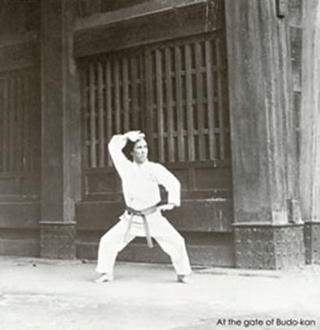
After the war Yamaguchi returned to Japan from a prisoner of war camp and found his worked to be cut out for him. He found his own school badly disorganized in his absence. He set to work with typical energy to rebuild. One thing that aided him was his dramatic appearance. He had taken to wearing his hair long, in the style of older Shinto priests and the samurais of old. As the ancient ways were being swept aside in the aftermath of war and the exposure to Western ideas, Yamaguchi reaffirmed his faith in the country's basic traditions by affecting the style of the ancient feudal lords.
Mr. Yamaguchi continued his efforts to expand the art of Karate in Japan. The decision to relocate the headquarters of the All Japan Karate-Do Goju Kai organization in Tokyo in 1950 resulted in a great jump in popularity for the style, both in Japan and abroad. He has contributed many distinguished services to the development of Karate. He originated the method of jiyu kumite (free sparring) that has come to be known as sport karate. He was the moving force behind the formation of the All Japan Karate Federation in 1964.
He was an apostle of calm meditation and philosophy and at the same time a restless, driving, and energetic head of a worldwide karate organization. Deeply suspicious of businessmen, he was himself the business head of what is one of the biggest and most financially successful karate systems in Japan.
He smiled, but not very often as he was gravely serious and reserved, with a seemingly bottomless reservoir of dignity. Domineering, humourless, he kept a tight karate fist on the operation of the organization and the more than 1,200 dojo and clubs and 600,000 members claimed for the Goju system. He has only two interests in life: his art and his religion. And it's difficult to tell just where the religious man leaves off and the karate man began.
Waterfall Training
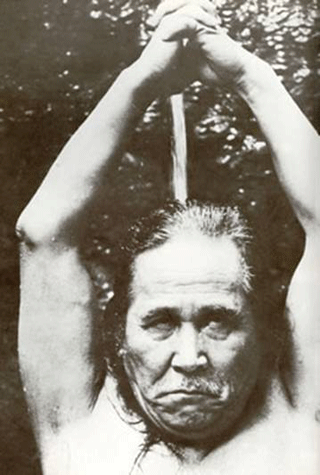
The martial arts requires much self-sacrificing effort and disciplining. For instance, Master Yamaguchi would out into the mountains once a month to toughen himself up spiritually and physically. He engaged in sanchin (breathing) exercises for several hours under an icy waterfall to try to make his mind and spirit impenetrable to adverse physical conditions.
During the coldest part of the winter, Yamaguchi set off for two weeks of gruelling exercises in snow-clad mountains. Each day started off with Yamaguchi and his followers pouring ice water over themselves, after which they ran around for a while before doing callisthenics and sanchin exercises under a stream of water that poured down on them. At the end of the training session, Yamaguchi, still fresh and bursting with vitality, led his charges on a barefoot run up the hill to the Ontake Shrine for a little Zazen meditation.
Until his death in 1989 Master Yamaguchi still kept a rigid schedule at home. He rose early and managed to get in an hour or more of meditation and more than an hour of kata practice by himself every morning. After breakfast and catching up on his correspondence and other business details, he puts in a full day teaching and working at the dojo. He could be found there most days from noon until 10 p.m.

